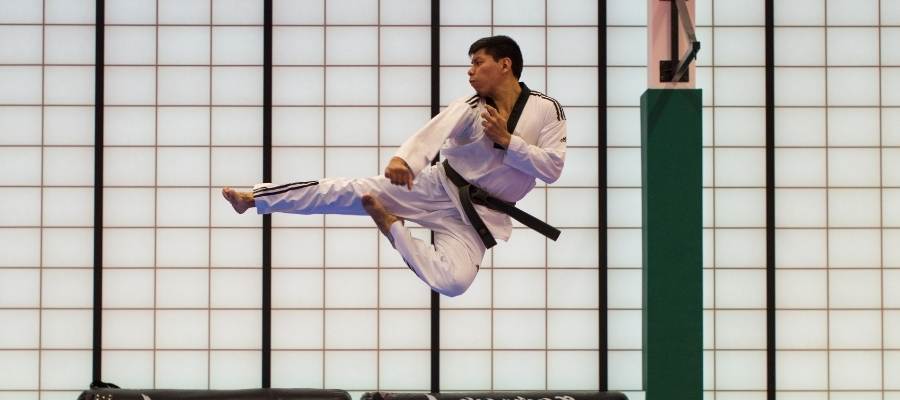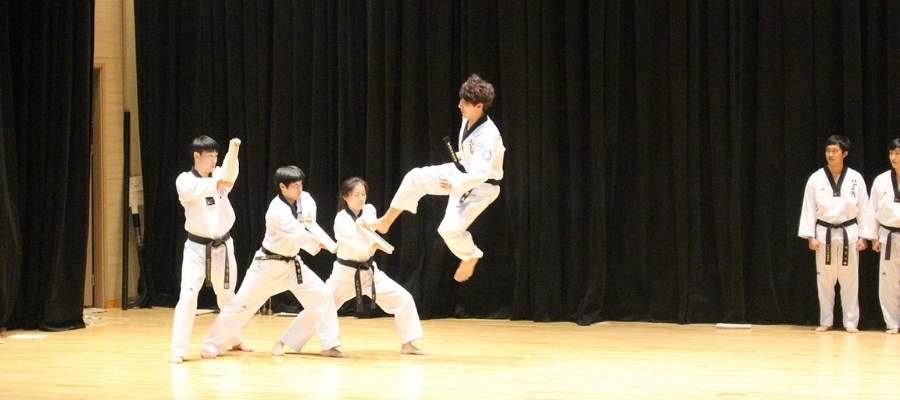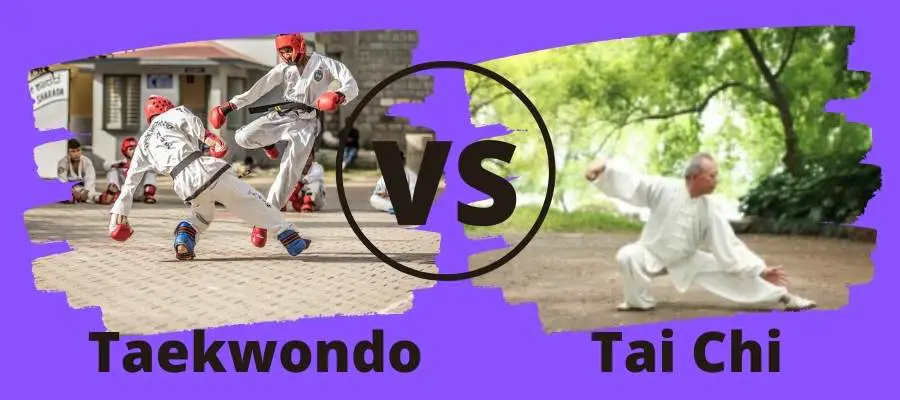The popularity and accessibility of classes in tai chi and taekwondo leads to a lot of people trying to choose between the two to find the perfect combination of fitness goals, time together with family members, and fun. One thing that both martial arts share is that they are often misunderstood by people new to the martial arts. Making a choice between tai chi vs taekwondo gets easy when you understand how they are different and a little bit about their history.
Tai chi originated in China several centuries ago and is characterized by solo form work that is slow and has a focus on health and wellbeing. Taekwondo is a Korean martial art that began after World War II that focuses on punches and kicking used in sparring with a partner and competitive fighting.
Let’s talk about why these two arts are so radically different in terms of history and purpose but also what they have in common. They are both great choices independently and actually complement each other when taekwondo schools decide to teach them together. One art focuses on the martial aspect, is flashy, fun, and competitive. The other focuses on health, calmness, and is a curative to the hard workouts of taekwondo.

Tai Chi vs Taekwondo – Origin and Key Differences
I want to start with the history of Taekwondo because most people assume all martial arts are just “old” but that is actually not the case here. Speaking openly, the Korean peninsula spent many years across the past several centuries at war or subjugated under the rule of countries like China and Japan. History is still coming to terms with the atrocities that occurred during these occupations but it is suffice to say that ruling powers actively worked to reduce and extinguish aspects of the Korean culture. And if you are the occupier, any fighting tradition is something that you definitely want to stamp out. Korea has/had three ancient martial arts traditions but very little made the transition into the 20th Century. Still, all of them influenced the modern day taekwondo.
- Taekkyon – A martial art characterized by whole-body technique that integrated strikes and throws with specialized stepping techniques.
- Subak– A martial art designed around open-hand techniques that may still be practiced in North Korea. A type of Subak dance still exists which contains martial-like movements.
- Gwonbeop – A martial art that is more similar to something like Kung Fu with forms of movements. It has a fair bit of historical writings that have been preserved.
Following the war, martial schools formed and adopted what was left of the old styles while incorporating what had been learned from Chinese and Japanese martial arts. After seeing a military martial arts fighting demonstration, exuberant South Korean president Syngman Rhee encouraged the formation of a national martial art soon to be known as Taekwondo or “The Way of Punching and Kicking.”
Taekwondo is a combat sport that gained popularity so quickly that it has an international federation and is an Olympic event. In terms of martial arts, there is nothing flashier or more athletic. It is renowned for it’s high spinning kicks and immense speed. Add to this the breaking of boards and flashy uniforms and you have quite a sport. I could continue to sit here talking about it or you can watch something jaw-dropping like this:
Kind of says it all, don’t you think?
Choosing Between Tai Chi vs Taekwondo
With such a stark contrast between the two arts, why are people considering doing tai chi vs taekwondo or both? It comes down to the availability of both arts and a few shared attributes.
Tai chi and taekwondo are both arts that contain solo forms. This is a way for a person to practice on their own, gage their progress, and come back to class with great questions and continue to advance.
Both arts have a shared love of personal development. With tai chi, it is internal and philosophical, as well as having an external focus on physical health. Taekwondo uses the physical demands of the sport and belt system to improve a person’s spirit, personal accomplishment, and confidence as they progress through achievements that they might not have thought were possible.
One philosophy that both share is a principle of cycling between focused striking and relaxation. Relaxation on taekwondo’s part results in faster movements and conserving the energy of the body for the next attack. In tai chi, the tightness and relaxation cycles create an undulation that releases stress and massages the organs through many of the movements.
That being said, children are much more attracted to taekwondo for all the obvious super cool reasons. I mean, who wouldn’t want to look like a gaming hero. If you are young, flexible, looking for physical fitness, competition, or want to fight, taekwondo is for you.
Tai chi has one of the longest histories of all of the marital arts and is therefore steeped in tradition. It has an immense community and when it is attached to a cultural center or activities, members can participate in a slew of events like dances, holidays, and calligraphy. The forms are longer, slower, and harder to memorize but definitely easier for adults. If you have physical restrictions to consider, tai chi is the way to go. I think that this question posted to a message board says it all:
“Is 18 too old to start Taekwondo?”

Choosing between Taekwondo and Tai Chi
If you want fitness, flashiness, fighting, and a lot of fun, Taekwondo is the obvious way to go. If you want more of a health focus, stress reduction, philosophy, and internal development, tai chi is for you. Past that, here are seven considerations that we have been using to compare other martial arts with tai chi. It’s a good way to determine which art you should consider based on what is important or available to you.
Physical Fitness
This one is a no-brainer. Taekwondo will get you fit. The physical fitness and speed designed into the art is purposeful. An original influence on the art was the research of Choi Hong Hi who incorporated principles of speed and physics into his work “The Theory of Power.” He advocates for the use of circling and speed to generate power which allows a smaller person to overcome a larger person.
The physicality of the art is also intentional to develop discipline, self control, self-esteem, and confidence by setting and achieving goals. Tai chi can’t compare here. Tai chi can get physically demanding during push hands and weapons forms but nothing remotely on the same level as taekwondo.
Popularity / Availability of Both Arts
Both arts are two of the most popular in the west. I have to give Taekwondo a little more credit here because they have not only established large schools but have invested time in developing weekend workshops, competition circuits, and afterschool programs for kids. Brilliant from a martial arts and marketing perspective!
Ability to Practice
For taekwondo you do need to go to a school to practice most of the time. Because this martial art also has individual forms, you can also practice on your own. The drills from the forms are mostly linear which are really easy to learn or refresh what you have learned from video sources. Tai chi, as we know, teaches solo forms so it can be practiced anywhere, anytime, with little to nothing.
Community / Socialization
Both tai chi and taekwondo have huge communities and multiple schools Just like tai chi has families or styles, taekwondo has styles and branches of styles. People who move have no trouble syncing up with a new school
Expense
Tai chi is less expensive than taekwondo. Taekwondo has dues like tai chi, but it also has a uniform, competition travel and training costs, often time has testing fees, and belt fees. Because taekwondo schools are often attended by entire families, this is not necessarily cost prohibitive. If a person competes, there is also expenses related to fighting gear and training equipment for striking and kicking.
Need for Gear / Location
Tai chi requires very little to train until you work up to the weapons forms. Taekwondo requires a uniform called a dobok, belts, and head and hand gear for competitions. Taekwondo schools have to be outfitted with a pretty large space and a lot of gear like striking pads and dummies. Not to mention a thickly padded floor. That being said, unlike other fighting arts like Aikido and BJJ that also need mats, Taekwondo practitioners can also practice on their own because the art has individual forms.
Putting it all together, I made a comparison chart showing the differences between tai chi and taekwondo. This is one of a series of articles where I compare tai chi to different martial arts.
A Comparison Chart of Tai Chi Vs Taekwondo
| Consideration | Tai Chi | Taekwondo |
|---|---|---|
| Self Defense / Fighting | 3 | 5 |
| Physical Fitness | 5 | 8 |
| Popularity / Availability | 10 | 8 |
| Ability to Practice | 10 | 10 |
| Community / Socialization | 7 | 7 |
| Expense | 10 | 6 |
| Need for Gear / Location | 10 | 7 |
| Average | 6.8 | 7.2 |
Choosing Between Tai Chi and Other Martial Arts
This is one of a series of articles covering the similarities and difference between tai chi and other martial arts. We all have very different personalities and luckily there is a martial art for everyone. What is important is that more people on the planet are pursuing fitness that is functional and addressing their external and internal development. Whatever you choice and where ever you are in life, we all benefit by having more people improve themselves and interact with a like-minded community. Check out how all the major martial arts compare to tai chi be clicking on the headings.
| Consideration | Tai Chi | Kung Fu | Wing Chun | Krav Maga | Muay Thai | MMA | Aikido | BJJ | Karate | Taekwondo |
|---|---|---|---|---|---|---|---|---|---|---|
| Self Defense / Fighting | 3 | 5 | 7 | 10 | 10 | 10 | 3 | 10 | 7 | 5 |
| Physical Fitness | 5 | 8 | 7 | 8 | 10 | 10 | 4 | 9 | 7 | 8 |
| Popularity / Availability | 10 | 8 | 8 | 3 | 5 | 9 | 10 | 10 | 8 | 8 |
| Ability to Practice | 10 | 10 | 4 | 3 | 3 | 4 | 6 | 7 | 6 | 10 |
| Community / Socialization | 7 | 7 | 7 | 5 | 4 | 6 | 7 | 8 | 7 | 7 |
| Expense | 10 | 6 | 8 | 8 | 4 | 4 | 8 | 6 | 8 | 6 |
| Need for Gear / Location | 10 | 7 | 8 | 6 | 4 | 4 | 4 | 4 | 8 | 7 |
| Total | 6.8 | 7.2 | 7 | 6.2 | 5.7 | 6.7 | 6 | 7.7 | 7.2 | 7.2 |



